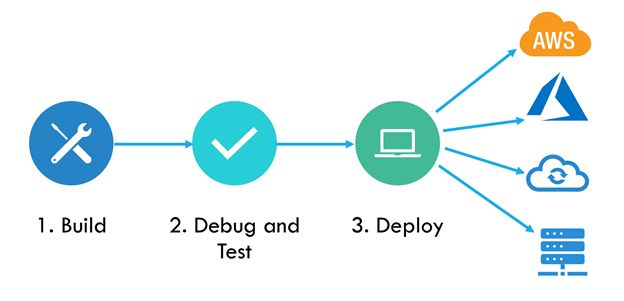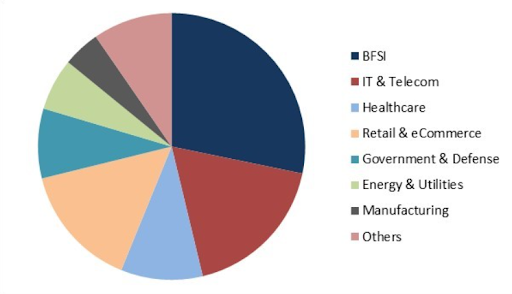Developing applications can often seem complex, time-consuming, and costly. What if you can create apps without the looming requirement of technical coding skills?
The less the code, the better it is, right? Many people find hours researching technical code and paying inordinate expenses on building interfaces absurd! Learning a whole programming language to type chunks of code sounds as irrational as it is time-taking. And that is why low-code applications come as a savior for entrepreneurs looking to accelerate their venture. Regardless of the industry sector, low code development is ideal for all.
Gartner estimates that almost 70% of new business applications will use low-code technology by 2025. Meanwhile, the market will cross $36.43 billion by 2027, owing to the soaring demand for low-code application development.
It is a frictionless way to transform and modernize. The use cases and benefits of low code are almost endless. But how to build a low-code platform? This article will present some benefits of low-code and a nine-step guide to developing a low-code application. So read ahead!
Common Low-Code Use Cases
Before you know how to build a low-code platform, let’s learn what you can develop by employing it. About 80% of IT departments will use low-code tools by 2026. The classic low-code example is a simple application built by a citizen developer, like a business analytics dashboard. But low-code tools can assist professionals in simplifying larger tasks and alleviate the tiring coding process. Some of its enterprise-level use cases include:
-
-
UI Design
-
The interface facilitates meticulous interaction between the program and the user. It is essential to build an engaging and responsive interface; hence, it can be more challenging than developing the actual application. Low code automatically produces interface code for an application UI. You can use it to design an interface and even personalize it per your suitability.
-
API Generation
ApI generation demands a lot of manual work. Another trouble occurs if you have legacy software that cannot support APIs. You can leverage low-code tools to generate APIs based on existing application code and implement them to upgrade or modify your business workflow.
-
Process Automation
Process automation application cuts down costs and saves time by reducing or eliminating manual or paper-based procedures. You can employ low code to integrate your existing core system with an automation platform. It will help relieve the burden off your employees and provide departmental and organization-wide advancements.
-
Business Process Management
Many Business Process Management systems furnish in-built low-code tools to streamline and analyze data management. You can access greater flexibility and configuration with minimal manual coding or deployment charges.
-
Platform Integration
Your antiqued legacy systems may fail to fulfill the current needs and trends. No need to move those systems out of your premises, especially when low code is there to help you out! You can integrate new features and capabilities effortlessly or rebuild your system if it is nearing the end of its life span.
-
Customer and Employee Portals
Retain crucial data of your employees and customers and deliver self-service experiences using low code. It allows you to create portals, customize functionalities, and reuse interfaces for internal and external users.
Easy Steps for Low-Code Application
Do you have an app idea for your business? Great! And you plan to undertake it using low-code tools and solutions? Brilliant! App development in low-code platforms is easy, so it should not be challenging, yes? Well, of course, low code will streamline the process and enable you to create apps even if you do not come from a technical background. In fact, it speeds up development by 90%. But how do you precisely employ these platforms to design applications?

Low-code platforms greet you with various automation, drag-and-drop features, personalized widgets, and novel tools. Regardless of how easy the app development seems, it is better to unleash your creativity and show developer skills later. You must follow some steps to build an apt application to answer current business needs.
1. Model the Process
Process modeling helps firms visualize the workflows to comprehend better, manage, and optimize their internal business procedures. Strategized and smooth processes power the applications and fuel them to deliver real business value.
- The first and itinerary step for creating a low-code application is to model the process.
- Next, you need to line it with your business requirements. It allows you to accurately communicate official functions, upgrade operations, and plan automation projects to digitize business operations.
- This way, you can identify areas of improvement, increase productivity, and set an agile environment for your application in the future.
Low-code tools like intuitive and drag-and-drop interface aid in crafting business process flowcharts effortlessly by delineating the process flow of your app to ensure each activity happens in the correct order. Further, it will provide smooth, end-to-end consistency and ensure process understanding among stakeholders across organizations.
2. Model the Data
Data is a valuable asset, but retaining it is more important. A lack of strategy to engineer and process data can result in unpleasant delays, run-down business relationships, and exasperated customers.
Data modeling allows you to perform multiple activities:
- Creating a database,
- Holding information about customers and products, and
- Tracking global sales trends
Once you define the steps and order in your process, determine the prerequisite data at each stage. Low-code tools assist in designing a data model that distinguishes and aligns the required information for different purposes in the process. You can create entities, attributes, and relationships without code. It gives you an edge over the competitors and directly impacts the business growth.
3. Define the Forms
User experience is one of the most crucial parts of the application. Users will only use your app when it is simple, responsive, and seamless. In short, if a customer finds the process of buying online complex, long, and intricate, then they will leave with a bad UX. You can lose about 90% of customers due to a bad experience. They wish for an easy-to-use application with faster loading time and seamless actions.

Although it begins and ends with customers, it immensely underlines your success. User experience includes everything that influences the perception and interaction with a product.
- Connect the process diagram and data structure acquired in previous steps to design an interface.
- A few low-code examples for building an interface are out-of-the-box controls and ready-to-use widgets, among other tools.
- You can select the information users furnish and see when using your low-code application.
4. Insert Business Rules
Business rules are low-code solutions for rule-based automation to enhance business agility. It is critical to structure how your application will process the extracted data from the database and display it. Business rules are simply programming logic that does just that while outlining relationships between objects. Business rules will take documented or undocumented information, translate it into conditional statements, and give a base for automation systems.
- You can capture business logic in decision tables and graphical modules and hold them at a central location before implementing it on the application.
- Ensure that the rules are accurate and precise as inadequate rule creation leads to opaque processes, less flexibility, and high expenses.
- You can avail of no-code and low-code capabilities to frame business rules. Multiple wizards are there to create logic in a simplified manner without requiring you to pen long codes.
5. Set the Performers
You hire your employees based on their efficiency and skill set for a particular job, correct? You have complete control over features and alternations when developing apps internally. You can position your employees depending on their expertise to carry out tasks.
- Evaluate your staff per their skills, location, technical background, language, workload, or any other factor, and assign tasks at different stages.
- Ensure that the right people are doing the right things at the right time to set up permissions and authorizations and sidestep confusion.
- It will help limit the unorganized workflow and improve the speed of your application.
6. Design Wireframes
Now is the time to bridge the gap between your thoughts and the desired final product. You have reached the first phase of visual development- Wireframing, where you will define and design the skeleton of your app.
- Wireframing refers to a visual representation of the layout and interaction of different screens within the application.
- It is a schematic blueprint that gives a hand in planning and communicating the application structure you are creating.
- Wireframes map the journey and determine the order, relation, and number of screens for tasks.
This way, you can develop a user-focused concept, prioritize information, and define app features. You can design multiple screens flows to decipher which ideally suits the users.
7. Choose a Custom App Development Path
Custom applications are those designed to meet specific business needs. They endeavor to address a particular obligation and save you from using multiple applications to fulfill a specific function. Once you have laid the wireframe and interface, you can proceed to the next step- making your app stand out and translating your ideas into a prototype while ensuring the development is easy on pockets.
- Begin with identifying people who will use your app and create their profiles to understand their requirements.
- You can instill interactive prototypes to enable users to leave constant feedback, which will help you make changes on the fly.
- Further, in-built the latest features ease integration, eliminate bugs, and expedite the Quality Assurance (QA) process.
8. Test your Mobile Application
Congratulations! Your application is almost ready, and you must be excited to launch it. However, hold on a moment! Imagine installing an app only to have it full of glitches. It doesn’t sound good, yes? That is why user testing is paramount; you must test every app you develop. It will give you an insight into how it works and avoid potentially disastrous issues.
- You can ask your team or select some loyal customers to use the app pre-launch and give their comments on how it works. Then, note the suggestions, remarks, and feedback they voice out, and analyze them.
- Ensure that your low-code application is working well on both- web and mobile screens.
- Mobile screens provide limited space; check if your design is practical and comprises significant elements.
9. Promote and Market your Application
Think again if you believe your work ends once you release the app. The day you launch your app, you throw your app into a sea filled with all sorts of applications and software. The prime purpose of a business application is to reach a wider audience. You created the app and put it out in the market, but how to lure customers into downloading it? Forget wider reach; how do you ensure regular customers stick with you in the intense competition?
- To market your application, utilize different promotion tactics like platform marketing, social media platforms, viral marketing, app store optimization, etc.
- Further, multiple perks and positive initiatives for loyal customers can help you retain consumers in both worlds, online and offline.
The Future of Low-Code App Development
Digitization is a pressing need, and by developing an application for your enterprise, you are on pace with current trends. About 62% of companies already have an application for better engagement and support. Whether to increase collaboration, automate service and data management, or accelerate application development, low code may be the perfect solution. It uses a feasible development approach and, like a custom dress, fits close to your business requirements. You can customize your tools into a tailored graphical interface.
Have an app idea but are hesitant to initiate the process yourself? Developing a low-code application without complete knowledge is the same as building a house without laying a proper foundation! Worry not; we’ve got you! Parangat is a mobile application development company striving to offer optimal software and apps to organizations. We aim to simplify workflow and enhance digital transformation by bridging the gap between business users and IT. Our adept team excels in engineering bespoke low-code applications to suit the requirements and needs of a particular client.

With roll up sleeves, dive in and get the job done approach, it was in the year 2010 when Sahil started Parangat Technologies. Emphasizing a healthy work culture and technology-driven company, he has successfully created a workplace where people love to work and live. He is a software engineer and a passionate blockchain enthusiast.


 +44-7511-112566
+44-7511-112566 +353-1-8079571
+353-1-8079571 +1-415-799-9792
+1-415-799-9792

